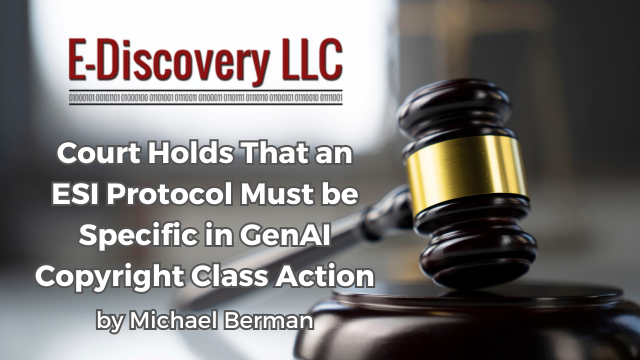
[EDRM Editor’s Note: The opinions and positions are those of Michael Berman.]
In Andersen v. Stability AI Ltd., 2025 WL 870358 (N.D. Cal. Mar. 19, 2025), the court resolved a dispute over an ESI Protocol.
The starting point was a Standing Order that, absent good cause, parties “shall use” one of the court’s model protocols.
The Andersen parties used a Model ESI Order as a starting point. They sought “adapt it to fit their needs but disagree about the appropriate extent of modifications.”
The court anticipated a large volume of ESI in “diverse forms” and, citing precedent, wrote:
“An ESI protocol has to be specific or it doesn’t mean anything.”
[Emphasis added; cleaned up].
One problem with ESI Protocols, and one of their advantages, is that – – unlike a “discovery plan” – – the term “ESI Protocol” is not defined anywhere. “ESI Protocol” v. “Discovery Plan” (Jan. 2, 2024).
In light of this, there is a debate over the degree of detail that is appropriate in an ESI Protocol:
Some say that they should be bare bones and address only a limited list of topics. Others suggest a comprehensive list that incorporates every potential bump in the electronic road that is described in any judicial opinion. Most stake out a middle ground and suggest tailoring the protocol.
Many (like me) agree with Kelly Twigger that: “An ESI protocol is your roadmap to handling ESI issues in any litigation. Like any trip you take, the more planning you do, the less speed bumps you hit….” Kelly Twigger, ESI Protocols Part I: Planning for eDiscovery—When, How and Why | eDiscovery Assistant….
In “Through the Looking Glass,” Lewis Carroll wrote: “When I use a word,’ Humpty Dumpty said in rather a scornful tone, ‘it means just what I choose it to mean — neither more nor less.’”
I think that part of the confusion in defining an ESI Protocol stems from the fact that “ESI Protocols” are not mentioned in the Federal Rules of Civil Procedure.
Id. (Emphasis added).
In the “Discovery Plan” blog, I suggested that:
An “ESI Protocol,” or its cousins like an “ESI Stipulation,” particularly if tailored to a minimalist approach, may be a great way to address ESI, but it may not fill this bill. And, the Federal Rules of Civil Procedure mandate that a “discovery plan” be submitted.
One solid approach is to negotiate an ESI Protocol as part of a discovery plan. Another may be to address the discovery plan later, but timely under Fed.R.Civ.P. 26(f)(2). An alternative could be to negotiate a “discovery plan” in lieu of an ESI Protocol.
In all events, however, the mandatory provisions of Rule 26(f)(2) cannot be ignored. Under Rule 26(f)(2), the parties must submit “to the court within 14 days after the conference a written report outlining the [discovery] plan.”
Id.
In Andersen, given the inability of the parties to reach agreement, the court went through the provisions one-by-one. For example:
Plaintiffs and Defendants have presented competing proposals under the headings “Search” and “ESI Search,” respectively. Plaintiffs propose a series of five subparagraphs that address disclosures, search methodology, search terms, hit reports, and validation. Defendants propose a single paragraph that focuses on the selection of search terms and search strings. The Court adopts in part Plaintiffs’ approach because it sets parameters for a series of topics related to ESI search that will clarify and advance cooperation for purposes of ESI discovery.
Andersen v. Stability AI Ltd., 2025 WL 870358 (N.D. Cal. Mar. 19, 2025).
The Court adopts in part Plaintiffs’ approach because it sets parameters for a series of topics related to ESI search that will clarify and advance cooperation for purposes of ESI discovery.
Andersen v. Stability AI Ltd., 2025 WL 870358 (N.D. Cal. Mar. 19, 2025).
Frequently, the Andersen court took a middle of the road approach. On one point, “[t]o strike an appropriate balance,” the court modified a proposal of plaintiff. On another:
On one hand, given the number of individual named Plaintiffs, Plaintiffs’ proposal raises the prospect of a significant, perhaps excessive number of custodians relative to the number and size of each Defendant and the issues involved in this case. At the same time, it is not clear from the record the number of employees at each defendant company, and whether each Defendant is a similarly sized company. On the other hand, Defendants’ counter proposal appears overly restrictive. To resolve the number of custodians, the Court directs that a Requesting Party may request up to twelve custodians per Producing Party. Named Plaintiffs are collectively considered a single “Requesting Party,” and “Producing Party.”
Id.
For another example, the Andersen court ordered: “Each Requesting Party shall limit its ESI production requests to a total of fifteen search terms per custodian per party. The search terms shall be narrowly tailored to particular issues. Indiscriminate terms, such as the producing company’s name or its product name, which are inappropriate unless combined with narrowing search criteria that sufficiently reduce the risk of overproduction.”
And, the court wrote that: “Defendants’ proposed ESI protocol does not address validation. It is appropriate for the ESI protocol to meaningfully address validation procedures….”
Defendants’ proposed ESI protocol does not address validation. It is appropriate for the ESI protocol to meaningfully address validation procedures….”
Andersen v. Stability AI Ltd., 2025 WL 870358 (N.D. Cal. Mar. 19, 2025).
The court also resolved a dispute over hyperlinks and privilege logs, as well as many others
This blog is not a criticism of counsel in Andersen. It is clearly a large and complex case. Counsel are clearly capable, sophisticated, and experienced. The court wrote that: “Plaintiffs, a group of visual artists whose works were allegedly used to train a generative artificial intelligence (AI) model called Stable Diffusion, brought this putative class action on behalf other similarly situated artists against Defendants, five companies that created and/or used Stable Diffusion. Among other claims, Plaintiffs allege that Defendants have engaged in widespread copyright infringement.”
I see three takeaways from the court’s decision.
First, Andersen reflects the sophistication of the judiciary in resolving ESI disputes. The court’s expertise in ESI issues, for example, protocol design, is clearly evident.
Second, if parties cannot reach agreement, neither may get what they want. When parties cannot agree, a court may find itself “in the uncomfortable position” of having to impose a methodology. William A. Gross Const. Assocs., Inc. v. Am. Mfrs. Mut. Ins. Co., 256 F.R.D. 134, 135 (S.D.N.Y. 2009)(Peck, J.)(search terms).
Litigation exemplifies risk. In Rayome v. ABT Electronics, 2024 WL 1435098 (N.D. Ill. Apr. 3, 2024), the court wrote that “it would be in the parties’ interest to reach a negotiated result. It should not be forgotten that a party could be ‘right,’ but find itself on the losing side of a court’s ruling.”
A similar principle was stated in Fleury v. Un. Pac. R. Co., 2024 WL 1620613 (N.D. Ill. Apr. 15, 2024), where the court wrote: “Courts have vast discretion in resolving discovery disputes and that often means there’s no right or wrong answer. See There’s No Right or Wrong Answer – But There Are Mistakes (Apr. 19, 2024).
In Andersen, it may not have been possible to reach a negotiated protocol. The facts and issues are complex and the issues reflect that complexity.
Cooperation cannot solve every dispute. “Cooperation is not capitulation.”[1] However, when negotiations fail, the result may not be what either litigant wants.
Notes
[1] M. Berman, et al., eds., “Electronically Stored Information in Maryland Courts” (Md. State Bar Ass’n. 2020), 340, quoting The Sedona Conference, W. Butterfield, “The Case for Cooperation,” 10 Sed. Conf. J. 339, 340 (2009); accord P. Grimm, “Practical Ways to Achieve Proportionality During Discovery and Reduce Costs in the Pretrial Phase of Federal Civil Cases,” 51 Akron L. Rev. 721, 736–37 (2017).
Assisted by GAI and LLM Technologies per EDRM GAI and LLM Policy.


